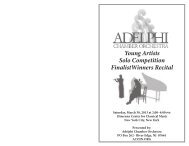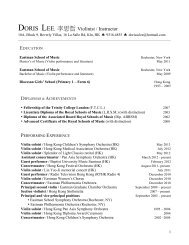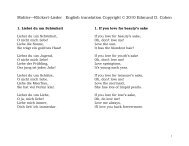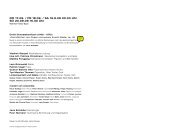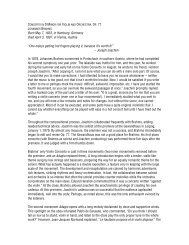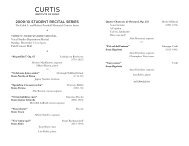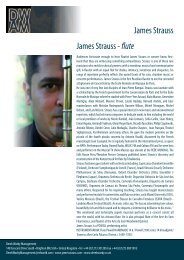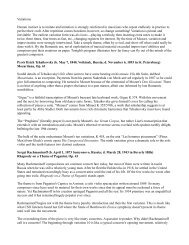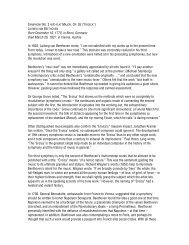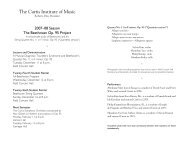Season Finale - InstantEncore
Season Finale - InstantEncore
Season Finale - InstantEncore
You also want an ePaper? Increase the reach of your titles
YUMPU automatically turns print PDFs into web optimized ePapers that Google loves.
Max Karl August Bruch<br />
Violin Concerto No. 1 in G Minor, Op. 26<br />
Bruch was born in Köln on January 6, 1838, and died near<br />
Berlin on October 2, 1920. Joseph Joachim premiered the revised<br />
version of his first violin concerto in Bremen on January 5, 1868.<br />
In addition to solo violin, the work calls for pairs of woodwinds, 4<br />
horns, 2 trumpets, timpani and strings.<br />
“In my youth, I studied violin for four or five years,”<br />
Max Bruch wrote in 1911, “and although I did not become<br />
an adept performer, I learned to know and love the instrument.<br />
The violin seemed to me even at that time the queen<br />
of instruments, and it was quite natural that I early had<br />
the inclination to write for it. Thus, my first concerto, Op.<br />
26, which was introduced to the musical world by Joachim<br />
during the season of 1867–1868, gradually grew. It was not<br />
at that time my intention, so far as I can remember, to write<br />
further works for the violin; and indeed, for years, I devoted<br />
myself to writing compositions in large form for chorus and<br />
orchestra. In 1873 I wrote Odyssesus and in 1875 Arminius<br />
(which is better known in America than in Germany) and<br />
in 1877 Das Lied von der Glocke.. . . I never had any special<br />
interest for the piano and I wrote only a little for it in my<br />
youth. I was destined by nature to write compositions for<br />
the voice, and I always studied singing with special interest<br />
and have associated largely with singers. This tendency has<br />
also, of course, been displayed in my violin works.”<br />
While Bruch’s Scottish Fantasy for violin and orchestra<br />
and Kol Nidre for cello and orchestra continue to appear on<br />
concert programs, today his fame rests almost exclusively<br />
on the first of his three violin concertos, which stands with<br />
those of Beethoven, Mendelssohn and Brahms among the<br />
greatest masterpieces of the 19th century. The celebrated<br />
Hungarian violinist Joseph Joachim even dubbed Bruch’s<br />
“the richest” and “most seductive” of the four.<br />
The first sketches for Bruch’s concerto date from 1857,<br />
around the time his first opera, Scherz, List und Rache, debuted<br />
in Köln. He completed it in early 1866, with the<br />
premiere slated for April 1, but when the intended soloist<br />
fell ill, violinist Otto von Königslöw stepped in to debut the<br />
concerto at a hastily rescheduled concert on April 24, with<br />
the composer conducting. Bruch subsequently withdrew<br />
the work to make revisions, sending the new manuscript<br />
to Joachim the following summer. Joachim provided helpful<br />
suggestions and participated in a private rehearsal at<br />
Hanover in October 1867. Bruch dedicated the concerto to<br />
Joachim, who performed the official premiere of the revised<br />
version the following January.<br />
Although cast in the standard three movements, Bruch<br />
originally labeled the opening Introduzione, quasi fantasia before<br />
settling on the title Vorspiel (“Prelude”). It leads without<br />
pause to the central Adagio, in which three distinct musical<br />
motives unfold in turn, most clearly demonstrating the linkage<br />
between Bruch’s vocal compositions and his writing for<br />
solo violin. The Gypsy-dance finale, marked Allegro energico,<br />
predates the similarly themed closing movement of Brahms’<br />
violin concerto by nearly a decade.<br />
Over the course of his long life, Bruch developed something<br />
of a love-hate relationship with this concerto. This may<br />
have been due in part to the fact that he sold the publishing<br />
rights to the work for a one-time fee and never saw any<br />
royalties from his first and greatest musical success. Late<br />
in life, after World War I left him in dire financial straits, he<br />
attempted to sell his autograph copy in the United States,<br />
but never received any payment prior to his death in 1920.<br />
Robert Schumann<br />
Symphony No. 3 in E♭ Major, Op. 97 (“Rhenish”)<br />
Schumann was born in Zwickau, Saxony, on June 8, 1810,<br />
and died near Bonn on July 29, 1856. He composed this symphony<br />
between November 2 and December 9, 1850. Schumann<br />
himself conducted the premiere in Düsseldorf on February 6 of the<br />
following year. The work calls for pairs of woodwinds, 4 horns, 2<br />
trumpets, 3 trombones, timpani and strings.<br />
Robert Schumann’s tenure as municipal music director<br />
at Düsseldorf, along the banks of the Rhine, would end<br />
badly: After averting a forced resignation in October 1852,<br />
he would step down the following year and in February<br />
1854 attempted suicide by jumping off a bridge into the<br />
Rhine. He would spend the remaining two years of his life<br />
in an insane asylum near Bonn.<br />
But Schumann’s arrival in Düsseldorf with his wife<br />
Clara, on September 2, 1850, marked a time of great optimism<br />
for the composer, sparking a period of inspired<br />
composition. He produced his remarkable cello concerto<br />
in a mere 15 days during October, and at the beginning<br />
of November began work on the last and greatest of his<br />
four symphonies (the so-called Symphony No. 4, published<br />
last, being a revision of a work first performed in 1841).<br />
“Robert is at work on something,” Clara wrote in her diary<br />
on November 16, “I do not know what, for he has said nothing<br />
to me about it.” Schumann completed the symphony<br />
in just over a month, presenting it to his wife as a surprise<br />
on December 9. He conducted the premiere the following<br />
February at Düsseldorf’s Geisler Hall on the sixth concert<br />
of the Allgemeine Musikverein. On March 19, 1851, the<br />
composer wrote to a publisher that his new work “perhaps<br />
mirrors here and there something of Rhenish life.”<br />
Schumann cast his symphony in five movements instead<br />
of the traditional four, although the majestic fourth<br />
movement can be viewed as grand slow introduction to<br />
the finale. The heroic theme of the opening movement, announced<br />
by horns, is one of Schumann’s most magnificent<br />
creations, its ingenious cross-rhythms obscuring the pulse<br />
of the 3 4<br />
meter until the seventh bar. Instead of the typical<br />
scherzo, Schumann follows with a ländler, a more deliberate<br />
dance form in 3 4<br />
time; at one point he appears to have subtitled<br />
the movement “Morning on the Rhine” but deleted all<br />
programmatic notations from the score before publication.<br />
Next comes a graceful intermezzo in place of the traditional<br />
slow movement.<br />
The fourth movement originally bore the subtitle, “In<br />
the character of the accompaniment to a solemn ceremony.”<br />
During November 1850, the Schumanns had traveled to<br />
Köln for a ceremony elevating the local archbishop to a car-



